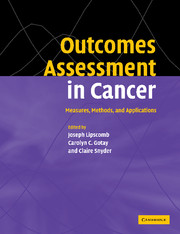Book contents
- Frontmatter
- Contents
- List of contributors
- Acknowledgments
- 1 Introduction to Outcomes Assessment in Cancer
- Health-related quality of life in cancer: general concepts and generic measures
- Assessing health-related quality of life during treatment
- Assessing health-related quality of life across the cancer continuum
- Measuring the experience and needs of cancer patients and caregivers
- Methodological considerations in applications to cancer outcomes research
- Modern psychometric theory in cancer outcomes research
- 21 Item response theory and its applications for cancer outcomes measurement
- 22 Applications of item response theory to improve health outcomes assessment: developing item banks, linking instruments, and computer-adaptive testing
- 23 Subscales and summary scales: issues in health-related outcomes
- Assessing the economic impact of cancer
- Research and policy implications
- Invited papers
- Index
- References
21 - Item response theory and its applications for cancer outcomes measurement
Published online by Cambridge University Press: 18 December 2009
- Frontmatter
- Contents
- List of contributors
- Acknowledgments
- 1 Introduction to Outcomes Assessment in Cancer
- Health-related quality of life in cancer: general concepts and generic measures
- Assessing health-related quality of life during treatment
- Assessing health-related quality of life across the cancer continuum
- Measuring the experience and needs of cancer patients and caregivers
- Methodological considerations in applications to cancer outcomes research
- Modern psychometric theory in cancer outcomes research
- 21 Item response theory and its applications for cancer outcomes measurement
- 22 Applications of item response theory to improve health outcomes assessment: developing item banks, linking instruments, and computer-adaptive testing
- 23 Subscales and summary scales: issues in health-related outcomes
- Assessing the economic impact of cancer
- Research and policy implications
- Invited papers
- Index
- References
Summary
Introduction
Each year new health-related quality of life (HRQOL) questionnaires are developed or revised from previous measures in the hope of obtaining instruments that are more reliable, valid within the study population, and sensitive to a patient's change in health status. Also, it is important that the measures provide interpretable scores that accurately characterize a patient's HRQOL. While several quality instruments have emerged in cancer outcomes research, we presently lack the ability to crosswalk scores from one instrument to another so that researchers are able to combine or compare results from multiple studies when different instruments are used. Developing these psychometrically strong measures requires analytical methods that will allow researchers to choose the best set of informative questions to match study objectives and to crosswalk scores from one assessment to another, despite use of different sets of questions.
There has been growing interest in learning how applications of item response theory (IRT) modeling can be used to respond to these analytical needs of the cancer outcomes measurement field. This interest is generated by the ability of IRT models to analyze item and scale performance within a study population; to detect biased items that may occur when translating an instrument from one language to another, or when respondents from two different groups hold culturally different meanings for the item content; to link two or more instruments on a common metric and thus facilitate crosswalking of scores; and to create item banks that serve as a foundation for computerized adaptive assessment.
- Type
- Chapter
- Information
- Outcomes Assessment in CancerMeasures, Methods and Applications, pp. 425 - 444Publisher: Cambridge University PressPrint publication year: 2004
References
- 3
- Cited by



